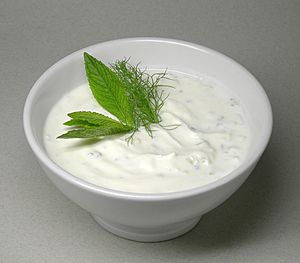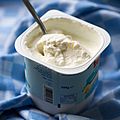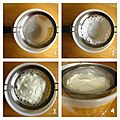Yogurt facts for kids
| Nutritional value per 100 g (3.5 oz) | |
|---|---|
| Energy | 257 kJ (61 kcal) |
|
4.7 g
|
|
| Sugars | 4.7 g (*) |
|
3.3 g
|
|
| Saturated | 2.1 g |
| Monounsaturated | 0.9 g |
|
Protein
|
3.5 g
|
| Vitamins | Quantity
%DV†
|
| Vitamin A equiv. |
3%
27 μg |
| Riboflavin (B2) |
12%
0.14 mg |
| Minerals | Quantity
%DV†
|
| Calcium |
12%
121 mg |
|
(*) Lactose content diminishes during storage.
|
|
| †Percentages estimated using US recommendations for adults. | |

Yogurt is a popular dairy product made from milk. It is created when tiny living things called bacteria ferment the milk. This process changes the lactose (a sugar in milk) into lactic acid. Lactic acid makes the yogurt thick and gives it a slightly sour taste.
To make yogurt, milk is first heated to about 80 °C. This kills any unwanted bacteria and helps the milk proteins set properly. After cooling to about 45 °C, special bacteria are added. The milk then stays at this warm temperature for 4 to 7 hours to ferment. You can also make yogurt from soy milk, which is called soy yogurt.
Yogurt is one of the oldest foods humans have made. People have been eating it for thousands of years, and it's enjoyed all over the world today. It's packed with good things like protein, calcium, and several B vitamins (like riboflavin, vitamin B6, and vitamin B12).
Contents
How do you spell "yogurt"?
In English, you can spell the word as 'yogurt' or 'yoghurt'. In Canada, 'yogourt' is also a common spelling. You can say it with a short 'o' sound or a long 'o' sound.
When did people start eating yogurt?
The first yogurts were probably made by accident. Wild bacteria likely fermented milk, creating a sour but tasty food.
The oldest writings that mention yogurt come from Pliny the Elder. He wrote that some people knew how to make milk thick and sour, but still delicious.
In 1905, a Bulgarian medical student named Stamen Grigorov studied the bacteria in Bulgarian yogurt. He found two types of bacteria that make lactic acid. One of these, a rod-shaped bacterium, was later named Lactobacillus bulgaricus.
A famous Russian biologist named Ilya Mechnikov, who won a Nobel Prize, was inspired by Grigorov's work. Mechnikov thought that eating yogurt regularly helped Bulgarian farmers live long lives. He believed that Lactobacillus bacteria were important for good health. He worked to make yogurt popular across Europe.
Why is yogurt good for you?
Yogurt is very healthy! It has lots of protein, calcium, riboflavin, vitamin B6, and vitamin B12. Many people who have lactose intolerance (meaning they have trouble digesting lactose in milk) can eat yogurt. This is because most of the lactose in yogurt has been changed into lactic acid by the bacteria.
Yogurt can also be helpful for health in other ways. For example, it might help prevent diarrhea that can sometimes happen when people take antibiotics.
Images for kids
-
Tzatziki or cacık is a dish made with yogurt, cucumber, olive oil, and fresh mint or dill.
-
Doogh is a savory yogurt drink, often served cold and sometimes with mint and salt.
-
Raita is a yogurt-based side dish from the Indian subcontinent.
-
Dadiah in a market.
-
Yogurt made from plant milk.
-
A drinkable yogurt made from water buffalo milk.
See also
 In Spanish: Yogur para niños
In Spanish: Yogur para niños














